Forum Replies Created
-
AuthorPosts
-
2thlaserSpectatorPaul,
The change in protocol from what you were taught is now 1.5W, 34/24 air/water Z-2 fiber, 4mm from apex, with at least 7 passes UP the canal to have complete sterilization. We have found that the energy levels of the 200um tip pass about 3-4mm beyond the tip, so no longer is it neccessary to go to the apex the final pass at .50W .
Email me if you have any more questions….we will be augmenting the procedures as we see more research come in I am sure, but this is the latest model that shows complete sterilization (98.6%) in the canals, and NOT going to the apex, as the apex is affected by the energy used at 1.5W.
Mark
Glenn van AsSpectatorCool Mark, did you do the research, could you share it with me at glennvanas@shaw.ca
Glenn
jetsfanSpectatorGraeme,
I have found that when I dissect cracks, very often they will spark. Is this from mercury that has leached into the crack, or is it something else?
Robert
Graeme MilicichSpectatorI disect these with air-abrasion. Reason? AA dessicates the fracture and you can readliy identifty it as you are dissecting it out.
Often they stop halfway through teh dentin. There is notihing other than AA and magnification that will let you identify a crack that is running out and has not extended all the way to the buccal surfaceCheers
Graeme MilicichSpectatorJust so others understand what I am going on about.
In the first image, a force in the direction of arrow 1 places the dentin in the bottom corner of the cavity under tension and a crack begins to slowly propogate from the base of the cavity, obliquely through the dentin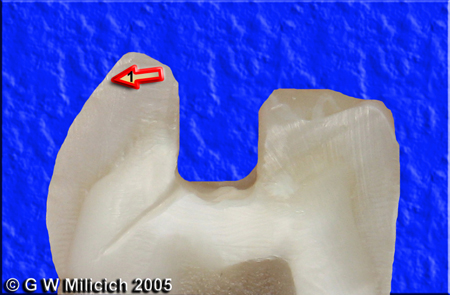
Constant cycling creates micromovement in the direction of arrow 2 and creates a cleavage plane. The dentin is no longer connected, so when the patient creates micro-movement by chewing, that creates a load in the direction of Arrow 1, and the gap opens slightly. Release of the pressure then causes a hydraulic pressure on the dentin tubules and causes PAIN. The common complatin is pain on chewing hard things and cold sensitivity, sometimes hot sensitivity (just like a debond under a composite. The solution is the same. Get rid of the microgap!!!)
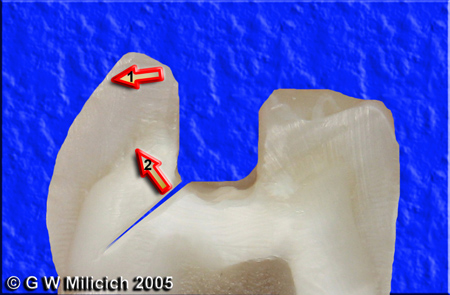
If you restore the tooth in this state, the crack is still there and continues to cause problems. Also, if you restore then prep for a crown, the section that is cracked is still dissociated from the underlying tooth, even if it is held in palce by some composite and will most likey still cause problems
Here is how I control the microgap and get rid of it. Most of these are done as in teh example below and I don’t bother crowning them. They remain functional and stable for years.
I have had 100% success in restoring these teeth by dissecting out the fracture using a fine bur or Air-abrasion. Often these cracks stop short of the enamel. If they make it all the way, the cusp falls off.In teh next image, I have dissected out the “crack” and reduced the cusp height and created a nearly full thickness bevel onto the buccal enamel
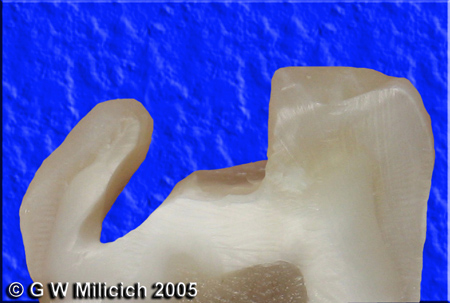
Then it is a simple matter of restoring the tooth either using a GIC composite co-cure restoration or a bonded composite. The advantages of this technique are that the margin – arrow 3- are ealy to finish and make very aesthetic and they are well above the gingival margin so there is little chance of microleakage and recurrent caries because it is finished on enamel, not dentin.
THe remaining cusp is now stable, there is no microgap still present that can continue moving creating thehydraulic decompression/compression cycle that causes all the pain.
.

The chance of exposure exists it the tip of arrow 4 and is totally dependent on the angle the fracture runs out at. If it exposes, so be it, but about 99% don’t and teh patient gets to avoid an endo. Occcasionally ther is an incredibly high pulp horn and you are doomed on these. Just have a really close look once you have dissected out the crack. I never remove dentin from the pulpal side of the crack, only the cuspal side, to avoid getting any closer to the pulp
Here is a case using this concept. (not good photos, I captured these with an intraoral camera several years ago)


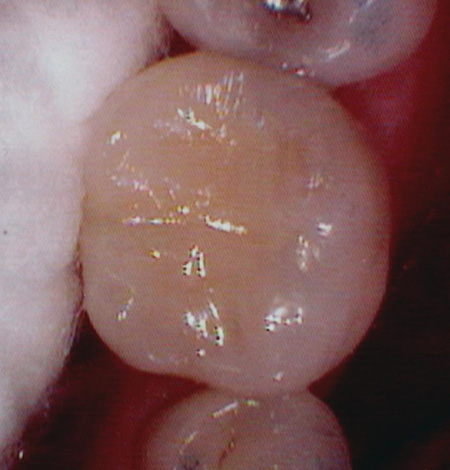
Works on any number of fractured cusps. You can crown thesetat any point, as long as you can establish a 2mm ferrule.
Cheers
(Edited by Graeme Milicich at 6:04 pm on May 26, 2005)
Robert Gregg DDSSpectatorKelly,
NOW I know why Sirona could care less about Patterson blackballing me over a measly 财 repair dispute and give up on 贄,000 for a Cerac………
http://www.sirona.com/ecomaXL/index.php?site=SIRONA_COM_press_sirolaser
Bob
(Edited by Robert Gregg DDS at 3:43 pm on May 26, 2005)
Robert Gregg DDSSpectatorQUOTEQuote: from Graeme Milicich on 2:23 am on May 26, 2005
There is notihing other than AA and magnification that will let you identify a crack that is running out and has not extended all the way to the buccal surfaceHave you ever tried a pulsed Nd:YAG for selective dissection of fracture lines?
I have found they are more precise and selective for these sorts of defects.
Bob
Graeme MilicichSpectatorBob
I don’t own an Nd:YAG, so I haven’t given it a try.
whitertthSpectatoranyone know a price?
SwpmnSpectator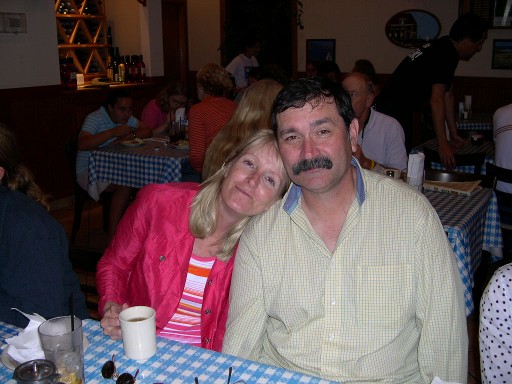
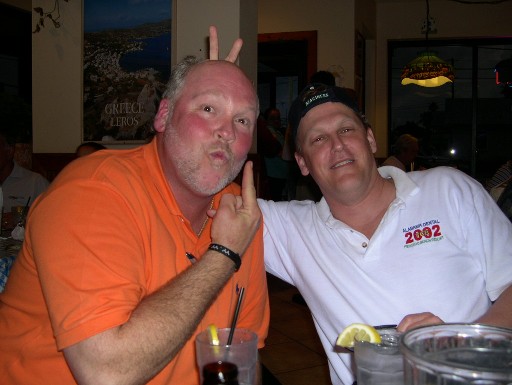

Glenn van AsSpectatorAllen I have some photos of you and your entourage that I MUST post this weekend. Thanks for the GREAT laughs and its awesome seeing all my net friends.
I will post the photos…..
By the way , I didnt fall for the kiss on the cheek of Rusty……the oldest trick in the book. SHeesh , next thing he will be showing up in a speedo on his ten speed……to sell me a laser.
Finally, Bob was showing how big a pocket he used the periolase on in his office last week……actually that might be the size of the Canadian wad of bills that I will need to buy one by the time he actually gets approval in Canada.
David is travelling so much these days, I hardly think he has anytime for posting these days. What I wonder is how he got such a nice wife…….
Grin
Cya and thanks again Allen , it really was great sharing a laugh or a dozen.
Glenn
mkatzSpectator“Bump” : There doesn’t seem to be much activity on this thread. I’m still thinking of buy a DEKA CO2 as a surgical tool. Considering the Periolase as a periodontal disease tx tool. I’d love to see posts of pictures of the DEKA in use…and comments about cost justification based upon the frequency at which it would be used in a perio practice.
mkatzSpectator6 months or so have passed since the last post – Has Elexxion yet provided copies of their published studies?
etienneSpectatorThis patient presented with bleeding gingiva associated with crowns apparently placed approx 3 years ago.
(Edited by etienne at 4:47 pm on May 30, 2005)
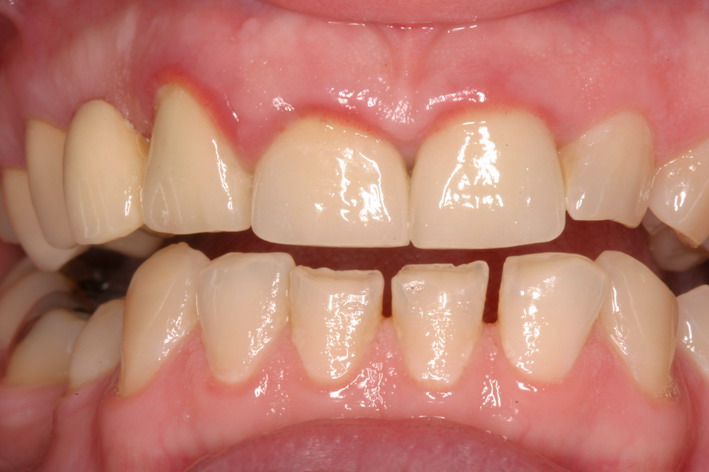
(Edited by etienne at 4:50 pm on May 30, 2005)
etienneSpectatorI removed the crowns by splitting them…
(Edited by etienne at 4:47 pm on May 30, 2005)

(Edited by etienne at 4:51 pm on May 30, 2005)
-
AuthorPosts
